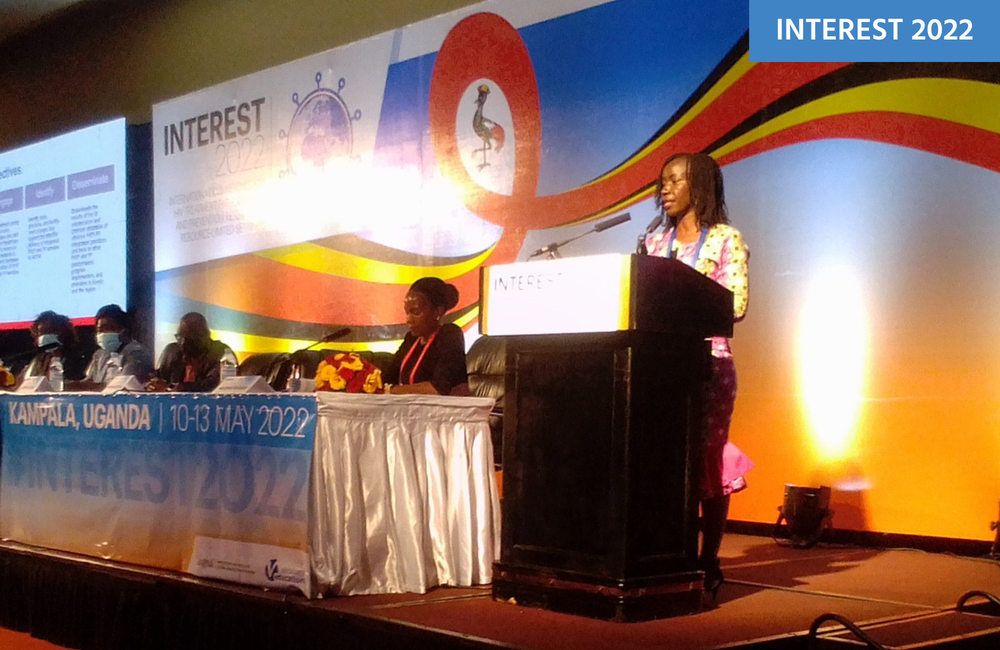
A seven-month programme in Kenyan public hospitals to increase access and uptake of oral PrEP among adolescent girls and young women had low uptake, with critical challenges encountered in health facilities, the INTEREST 2022 conference in Kampala heard this week. The researchers make several recommendations for how uptake could be increased.
Patriciah Jeckonia of LVCT Health presented results from a study of three high-volume public health facilities which aimed to integrate PrEP services into family planning services between April to October 2021. Out of 179 adolescent girls and young women who were eligible, only 43% started PrEP.
While Kenya has been able to successfully scale-up PrEP in public hospitals, most users are partners of people living with HIV, with a median age of 31 years. However, the group likely to get maximal benefit of PrEP in Kenya are adolescent girls and young women between 15-24 years who face high HIV incidence, are rarely aware of their male partner’s HIV status, and do not take proactive steps to start PrEP for HIV prevention.
To advance the integration of PrEP services for adolescent girls and young women, the CHOICE project, supported by PEPFAR and USAID, piloted PrEP-family planning services in three health centres in Nairobi.
Family planning providers were trained on how to integrate PrEP in their work and provided with job aids and a rapid assessment tool. During the implementation period, there were weekly facility coaching visits and refresher trainings. Adolescent girls and young women were trained as PrEP champions to assist with demand creation.
The providers screened family planning clients, and those eligible were referred for further PrEP assessment at a referral facility. Here, the clients had further assessment for PrEP and those found to be eligible started PrEP. Because most family planning providers did not have adequate training on PrEP delivery, and since PrEP was provided in HIV care clinics, all the providers in the three facilities opted to refer their clients to district and referral hospitals.
Between April to October 2021, there were 6,624 adolescent girls and young women who attended the facilities for family planning services. Jeckonia told the conference that while they expected all patients to be screened for PrEP eligibility, the providers only screened 61% of these patients. Of the 758 patients who were eligible for referral to PrEP after screening, the providers only referred 78%. Last, of 179 patients who were eligible for initiation, only 79 (43%) started PrEP.
Jeckonia explained the various challenges faced at the facility level. Providers complained of a high workload and many had a negative attitude and risk biases towards PrEP. “If a young woman walked in and said she is married but her husband was working in a different county or town, she would be questioned why she needed PrEP,” Jeckonia said. “The providers felt married women were not at risk.”
Other challenges included high rates of staff turnover, a lack of cohesion and teamwork between providers in PrEP, family planning and HIV testing services, inconsistent documentation, inconsistent use of the rapid assessment tool, and providers expecting additional payments for integrated services.
Many of the clients were not ready to start PrEP the same day it was offered, while some declined for fear of intimate partner violence. However, some of those who accepted the referral left due to long queues or “getting lost” on their way to see the next provider.
Some of the key lessons and recommendations shared from this programme include:
- Family planning, HIV testing, and PrEP providers should be trained together on PrEP-family planning integration to foster cooperation.
- The value of integrating these services should be emphasised by facility, local and national leaders. Coaching and supervision are needed.
- More than one provider in each service delivery point should be trained and equipped to provide combined services, so that if a provider transfers or goes on leave, integrated services can continue.
- Ensure an adequate supply of HIV testing kits and other commodities.
- Given high staff turnover, training on PrEP-family planning integration should be given before providers begin service and supplemented in on-the-job sessions.
- Ongoing training on adolescent-friendly services and reducing provider biases toward PrEP use among adolescent girls and young women is needed.
- Greater investment in awareness raising and demand creation for PrEP among adolescent girls and young women both in the community and at the facility (e.g., through health talks in the waiting room) are needed to increase readiness for PrEP.
- More work to address structural barriers to PrEP uptake by adolescent girls and young women – e.g., gender-based violence, stigma, and relationship dynamics with male partners.
“Although the number of family planning clients who started PrEP over seven months was low, the project illuminated critical challenges — and potential solutions — related to operationalising service integration in high-volume public health facilities”, Jeckonia concluded.
Jeckonia P et al. Moving from rhetoric to reality: Lessons learned from integrating oral PrEP and family planning services in public health facilities in Nairobi, Kenya. INTEREST 2022 conference, Kampala, abstract 5, 2022.
